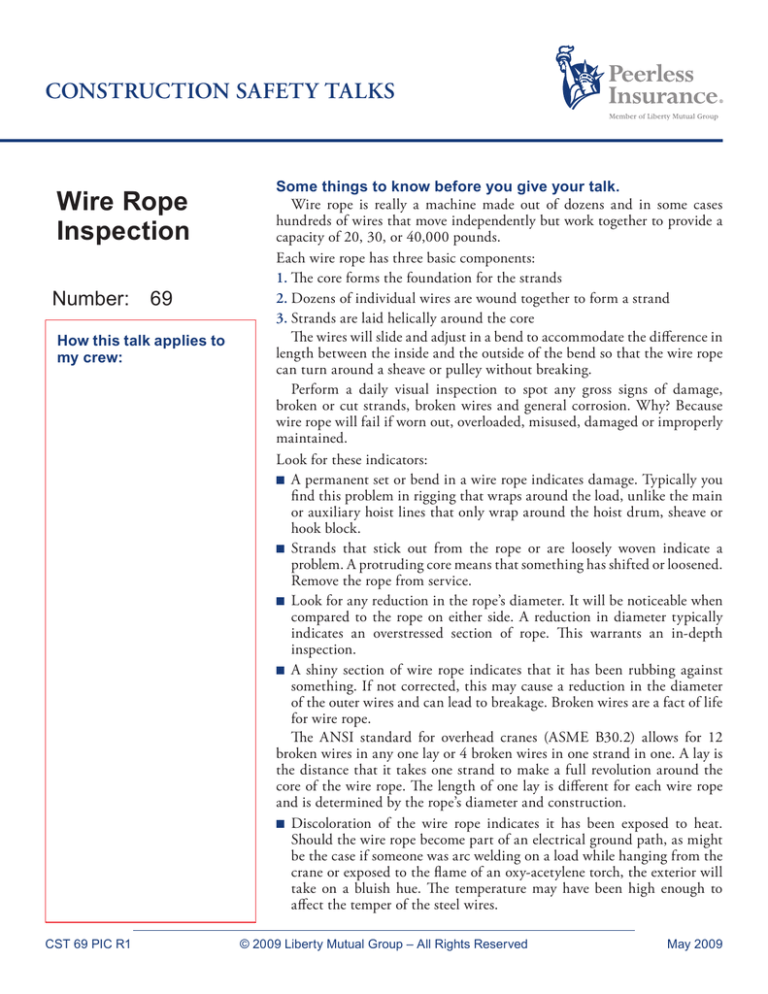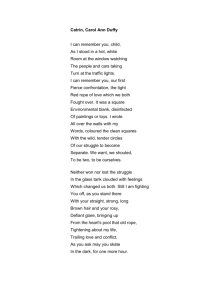
Construction Safety Talks
Wire Rope
Inspection
Number:
69
How this talk applies to
my crew:
CST 69 PIC R1
Some things to know before you give your talk.
Wire rope is really a machine made out of dozens and in some cases
hundreds of wires that move independently but work together to provide a
capacity of 20, 30, or 40,000 pounds.
Each wire rope has three basic components:
1. The core forms the foundation for the strands
2. Dozens of individual wires are wound together to form a strand
3. Strands are laid helically around the core
The wires will slide and adjust in a bend to accommodate the difference in
length between the inside and the outside of the bend so that the wire rope
can turn around a sheave or pulley without breaking.
Perform a daily visual inspection to spot any gross signs of damage,
broken or cut strands, broken wires and general corrosion. Why? Because
wire rope will fail if worn out, overloaded, misused, damaged or improperly
maintained.
Look for these indicators:
■ A permanent set or bend in a wire rope indicates damage. Typically you
find this problem in rigging that wraps around the load, unlike the main
or auxiliary hoist lines that only wrap around the hoist drum, sheave or
hook block.
■ Strands that stick out from the rope or are loosely woven indicate a
problem. A protruding core means that something has shifted or loosened.
Remove the rope from service.
■ Look for any reduction in the rope’s diameter. It will be noticeable when
compared to the rope on either side. A reduction in diameter typically
indicates an overstressed section of rope. This warrants an in-depth
inspection.
■ A shiny section of wire rope indicates that it has been rubbing against
something. If not corrected, this may cause a reduction in the diameter
of the outer wires and can lead to breakage. Broken wires are a fact of life
for wire rope.
The ANSI standard for overhead cranes (ASME B30.2) allows for 12
broken wires in any one lay or 4 broken wires in one strand in one. A lay is
the distance that it takes one strand to make a full revolution around the
core of the wire rope. The length of one lay is different for each wire rope
and is determined by the rope’s diameter and construction.
■ Discoloration of the wire rope indicates it has been exposed to heat.
Should the wire rope become part of an electrical ground path, as might
be the case if someone was arc welding on a load while hanging from the
crane or exposed to the flame of an oxy-acetylene torch, the exterior will
take on a bluish hue. The temperature may have been high enough to
affect the temper of the steel wires.
© 2009 Liberty Mutual Group – All Rights Reserved
May 2009
While there are many special-purpose ropes, in general, fiber core wire rope should not be used in areas with
temperatures above 200°F. Ropes with independent wire rope cores can be used at temperatures from minus 40°F
to 400°F. Check the manufacturer’s instructions for precise information.
The working strength of a wire rope will vary based on its use. For example, to calculate the “working” strength
of wire rope used on an overhead crane, ANSI B30.2 requires the user to apply a design factor of five. The user must
look up the maximum strength of the wire rope as provided by the manufacturer, also known as the “nominal” or
“catalog” strength and divide it by 5 to calculate the working strength.
Try this for show and tell!
Take a small section of brand new wire rope and ask the group to check for broken wires while at the same time
moving your bare hand up and down above the wire rope – be careful not to touch it! Make a point that this should
never be done on a working wire rope.
Next use a shop rag or glove to demonstrate the correct way to check a wire rope for broken wires. Wrap the rag
or glove loosely around the wire rope and move it up or down. A broken wire will “catch” and stop the rag. Make
sure to turn the rope 180° and repeat the process so that the entire diameter is checked.
Discuss methods that can be used to mark broken wires and what should be done after they are discovered.
Demonstrate the length of “one lay,” the distance for a strand to make one revolution around the core.
Questions you can use to get them talking:
■ Are there any areas of the shop/plant that have temperatures higher than 200°F? 400°F?
■ Does “dragging” or “rubbing” a wire rope across a structural member damage the rope?
Attended By:
The illustrations, instructions and principles contained in the material are general in scope and, to the best of our knowledge,
current at the time of publication. No attempt has been made to interpret any referenced codes, standards or regulations.
Please refer to the appropriate code-, standard-, or regulation-making authority for interpretation or clarification. Provided that you always
reproduce our copyright notice and any other notice of rights, disclaimers, and limitations, and provided that no copy in whole or in part
is transferred, sold, lent, or leased to any third party, you may make and distribute copies of this publication for your internal use.
CST 69 PIC R1


